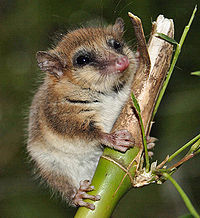Microbiotheria
| Microbiotheres
| ||||||||||||||
|---|---|---|---|---|---|---|---|---|---|---|---|---|---|---|
 | ||||||||||||||
| Scientific classification | ||||||||||||||
| ||||||||||||||
|
†Khasia |
Template:More footnotes
The monito del monte is the only extant member of its family (Microbiotheriidae) and the only surviving member of an ancient order, the Microbiotheria.[1] The oldest microbiothere currently recognised is Khasia cordillerensis, based on fossil teeth from Early Palaeocene deposits at Tiupampa, Bolivia. Numerous genera are known from various Palaeogene and Neogene fossil sites in South America. A number of possible microbiotheres, again represented by isolated teeth, have also been recovered from the Middle Eocene La Meseta Formation of Seymour Island, Western Antarctica. Finally, several undescribed microbiotheres have been reported from the Early Eocene Tingamarra Local Fauna in Northeastern Australia; if this is indeed the case, then these Australian fossils have important implications for understanding marsupial evolution and biogeography.
Although once thought to be members of the order Didelphimorphia (the order that contains the Virginia opossum), an accumulation of both anatomical and genetic evidence in recent years has led to the conclusion that microbiotheres are not didelphids at all, but are instead most closely related to the Australasian marsupials; together, the microbiotheres and the Australian orders form the clade Australidelphia. The distant ancestors of the monito del monte, it is thought, remained in what is now South America while others entered Antarctica and eventually Australia during the time when all three continents were joined as part of Gondwana.[2][3]
ReferencesISBN links support NWE through referral fees
- ↑ Template:MSW3 Microbiotheria
- ↑ Schiewe, Jessie (2010-07-28). Australia's marsupials originated in what is now South America, study says. LATimes.Com. Los Angeles Times. Retrieved 2010-08-01.
- ↑ Nilsson, M. A. and Churakov, G.;, Sommer, M.; Van Tran, N.; Zemann, A.; Brosius, J.; Schmitz, J. (2010-07-27). Tracking Marsupial Evolution Using Archaic Genomic Retroposon Insertions. PLoS Biology 8 (7): e1000436.
External links
| Mammals |
|---|
| Monotremata (platypus, echidnas) |
|
Marsupialia: | Paucituberculata (shrew opossums) | Didelphimorphia (opossums) | Microbiotheria | Notoryctemorphia (marsupial moles) | Dasyuromorphia (quolls and dunnarts) | Peramelemorphia (bilbies, bandicoots) | Diprotodontia (kangaroos and relatives) |
|
Placentalia: Cingulata (armadillos) | Pilosa (anteaters, sloths) | Afrosoricida (tenrecs, golden moles) | Macroscelidea (elephant shrews) | Tubulidentata (aardvark) | Hyracoidea (hyraxes) | Proboscidea (elephants) | Sirenia (dugongs, manatees) | Soricomorpha (shrews, moles) | Erinaceomorpha (hedgehogs and relatives) Chiroptera (bats) | Pholidota (pangolins)| Carnivora | Perissodactyla (odd-toed ungulates) | Artiodactyla (even-toed ungulates) | Cetacea (whales, dolphins) | Rodentia (rodents) | Lagomorpha (rabbits and relatives) | Scandentia (treeshrews) | Dermoptera (colugos) | Primates | |
Credits
New World Encyclopedia writers and editors rewrote and completed the Wikipedia article in accordance with New World Encyclopedia standards. This article abides by terms of the Creative Commons CC-by-sa 3.0 License (CC-by-sa), which may be used and disseminated with proper attribution. Credit is due under the terms of this license that can reference both the New World Encyclopedia contributors and the selfless volunteer contributors of the Wikimedia Foundation. To cite this article click here for a list of acceptable citing formats.The history of earlier contributions by wikipedians is accessible to researchers here:
The history of this article since it was imported to New World Encyclopedia:
Note: Some restrictions may apply to use of individual images which are separately licensed.